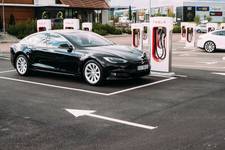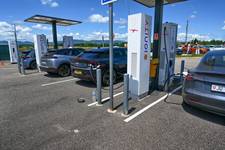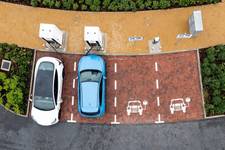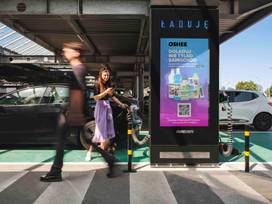Brick-and-mortar retail stores are constantly looking for new ways to drive revenue, especially since the COVID-19 pandemic accelerated the shift to online shopping. And there’s been a lot of talk about the revenue potential of retail media networks in recent years— for good reason! But retail site owners are also uniquely positioned to capitalize on another trend that was accelerated by the pandemic: the need for public EV charging infrastructure.
Retail sites that host EV charging infrastructure can attract a new customer base, increase the amount of time and money consumers spend on site, and benefit from positive corporate branding, customer loyalty, and new advertising opportunities. All this, plus the potential to add new revenue streams from direct sale of charging to customers or advertising revenue from on-charger displays. Read on to learn more about the unique opportunities and business benefits available to retailers with public EV charging infrastructure.
Benefits of EV charging stations for retail
In today’s competitive retail landscape, businesses must find creative ways to attract customers while also boosting the value of each transaction. Transforming your a retail location into an EV charging destination is one of the simplest ways to do just that. Below are a few examples of how hosting public EV charging stations can benefit retailers, as well as become a new revenue stream all on its own.
Attract valuable new customers
EV drivers are a highly desirable market segment for brands to interact with. They’re innovators and early adopters, have higher disposable incomes, and are generally very receptive to new products and innovations. By hosting charging stations on your retail site, you can boost your brand visibility on platforms that help drivers locate nearby charging stations—putting your location, quite literally, on the map for this covetable demographic. Plus, once these drivers know a location offers this valuable service, they’re likely to turn into loyal, repeat customers.
Increase time spent at your location
In addition to attracting new EV customers, charging stations can increase the amount of time your existing customers spend inside nearby store(s) while they wait for their vehicles to charge. Data analysis by Atlas Public Policy supports this claim, showing average charging times of more than two hours at retail locations—a number considerably higher than the 30 to 40 minute average store dwell times reported by InMarket for several large warehouse club chains, department stores, and grocery stores without on-site EV charging.
Enhance your brand reputation
Consumers today prefer to shop at, and employees prefer to work for, environmentally conscious businesses; according to a recent survey, more than 50% of the general population would be more interested in doing business with a company that commits to sustainability efforts. Hosting EV charging stations at your retail site can signal your company’s commitment to sustainability goals and contribute to an environmentally conscious or “green” reputation.
READ MORE: EV charging stations & digital signage: A guide to EV place-based advertising
How retail sites can monetize EV charging stations
Attracting new climate-conscious customers, improving your corporate image, and increasing the amount of time (and money) spent at your location are all excellent examples of how hosting public EV charging stations can help drive profitability. But there’s another key way EV charging can boost profits for retail site owners: the revenue earned from the stations themselves.
The revenue model(s) available to your network will depend on the EV charging business model you choose, but you should also consider factors such as site location, intended use, and average dwell time when creating your monetization strategy. For example, the sky-high demand charges and competition from utility companies in some parts of the US have made offering EV charging services unprofitable for convenience stores, but these fees can be less significant for EV operators with a high volume of customers.
As an alternative to (or in combination with) EV charging usage fees, presenting digital out-of-home (DOOH) ads on chargers equipped with digital screens can be a great way to defray these operational costs while generating an entirely new direct revenue stream.
In short, retail site hosts can seize a huge opportunity by hosting EV charging infrastructure, but they also need to be strategic when it comes to monetization tactics and goals.
EV charging business models for retail site operators
EV chargers installed at retail locations typically use one of two primary business models: owner-operator or third-party owned and operated. Before getting into the different revenue models and monetization strategies that are possible, it’s important to understand which EV charging station business model is the best fit for your retail business, as this will impact the amount of control you have over fees and setting a pricing structure.
In the third-party owned and operated business model, the location’s owner leases space to a third-party EV charging service supplier and typically has limited or no control over the price customers are charged for use of the EV charging stations. But, this means they’re also not responsible for station installation or maintenance, utility coordination, or other operational costs. The owner-operator, on the other hand, has complete control over pricing but is also often responsible for coordinating station maintenance, working with their electric utility company, and covering any operating costs associated with the EV charging infrastructure.
There are pros and cons to each of these business models, and the right choice for your retail site will depend on a number of unique factors, including the total number of sites you have, your site location(s), and how you intend the EV infrastructure to be used. To help potential retail site hosts understand the circumstances under which different business models are financially viable, we’ve outlined each of them in more detail below.
Third-party owned and operated
Pros:
- Limited exposure to operational cost overruns
- Protected from unexpected maintenance costs
Cons:
- Reduced control over customer experience
- No say in charging fee structure and pricing
- Limited profit potential from the stations themselves
In the third-party owned and operated business model, the site owner leases space to a third-party who then installs and operates the charging infrastructure. The site owner is not responsible for station maintenance, utility coordination, or other operating costs, but has limited or no control over the prices or pricing structure.
Depending on the leasing agreement, rental income from the charging stations can provide a consistent stream of revenue. And on-site retail stores are still able to reap the benefits of additional sales revenue from new customers or customers spending more time in stores. However, site owners that rely on a third-party charging service provider may give up control over the customer experience and relinquish the opportunity to realize the full amount of revenue from the charging station’s operation. In short, retail site hosts relying on third-party owner-operators limit financial risks, but they also limit their profit potential.
Owner-operator model
Pros:
- Direct relationship with consumers
- Full access to charging data (who, when, how long, how much)
- Control over charging income model and customer experience
Cons:
- Responsible for station maintenance and operating cost
Owner-operators purchase EV charging equipment from an EV charging service supplier and have complete control over the pricing structure and customer experience. But with more control comes additional responsibilities. After installation, the operation, maintenance, utility interconnection, and any other considerations for operating the charging station are the responsibility of the, though charging service providers offer warranties that cover repair and replacement of parts and assistance with common problems encountered when coordinating with utilities.
Well-situated charging stations have the potential to bring significant financial benefits to the owner-operator. But if owner-operators locate their chargers in unfavorable markets or pursue fee structures that negatively impact utilization or dwell time, then the costs of operating stations can exceed the benefits. Essentially, business models where the retail site owner is the owner-operator offer high profit potential but come with some associated financial risks.
Potential revenue sources and EV charging monetization tactics
The amount of decision-making power you’ll have as a retail site host will depend on your chosen EV charging station business model. But regardless of whether you’re an owner-operator with complete control or you’ve decided to lease space to a third-party charging service provider, it’s helpful to have a clear understanding of the different revenue models that are used to monetize EV charging stations.
When it comes to generating revenue directly from the chargers themselves, you currently have two main sources/options:
Charging a fee for EV charging
There is some obvious value that can be derived from direct sources of revenue, like drivers paying a subscription or fee for EV charging. This typically entails charging for the amount of energy being used (i.e., $0.25/kWh) or the amount of time spent plugged into a charger (i.e., $5.25/hr). Some sites offer a combination of the two charging forms (i.e., $0.75/kWh + $0.45/hour) as a way to reduce the hourly rate while still ensuring guests don’t “camp out” in a spot when their car is fully charged. Others charge a flat rate or membership fee for use of their EV charging.
Billing structures like these offer a simple and effective way to offset the cost of operating your charging stations. However, charging higher fees could discourage use or limit the amount of time customers spend charging. Depending on how you intend for your charging infrastructure to be used, fees designed to turn a profit from the sale of charging services could end up backfiring. Your retail site might be better served by a fee structure aimed at increasing customer dwell time, such as session-based fees or even free charging—especially since a recent financial analysis of common business models for retail site hosts found that ensuring high initial utilization was critical for achieving profitability in the long term.
Place-based advertising
An alternative EV monetization strategy that’s been gaining traction in recent years leverages increased demand for digital out-of-home (DOOH) and retail media network (RMN) ad placements. That’s right, we’re talking about place-based EV charging station advertising.
When you look at EV charging as a form of advertising, everything changes. Digital screens on EV charging stations placed in busy retail sites have the potential to reach a huge audience of on-site consumers, not just EV owners—making them highly valuable advertising opportunities for marketers seeking new ways to meaningfully engage with their customers.
While user fees are an effective tool to mitigate the risk of unprofitability, advertising revenue has been shown to have the largest impact on EV charging station profitability. Adding digital signage to your EV charging stations opens up exciting new possibilities for monetization through ad sales. Plus, you can save some of your DOOH inventory to run digital messaging of your own.
READ ALSO: How ChargeEuropa is powering Poland and Croatia with DOOH-enabled EV charging stations
3 reasons retail sites should incorporate EV charging stations with digital signage
Offering EV charging services while customers are shopping is only the beginning. The real opportunity is to steer EV drivers to selected retail sites and influence customers close to the point of purchase. And the best way to do that? Expand your retail media network to the parking lot with EV charging stations that come equipped with digital signage.
The main reasons why retailers should prioritize EV charging stations with digital signage can be summarized as follows:
Consumer expectations are evolving
In an era of widespread digitization and personalization, today’s consumer expects to be served contextually relevant and engaging content, whether they’re shopping from their computer or mobile device or pulling up to a brick-and-mortar store. At the same time, people are becoming more climate conscious and want to spend their money at retailers who share similar values. In fact, studies have shown there are millions of consumers who would be more likely to engage with a brand that puts sustainability front and center.
As consumers return to in-person shopping, the most successful retailers are bridging the gap between digital and physical shopping to create a unified, customer-centered shopping experience that moves seamlessly across channels and devices—and one of the best ways to bring the digital experience to brick-and-mortar retail stores is through digital signage. EV charging stations equipped with digital screens offer retail sites a uniquely effective way to meet evolving consumer expectations, helping to improve the in-person shopping experience and creating a positive perception of on-site brands amongst climate-conscious consumers.
READ ALSO: How to enhance the in-store retail experience with digital signage
Influence shoppers close to the point of purchase
Aside from generating direct revenue through ad sales, retailers can (and definitely should!) use digital signage attached to on-site EV charging stations to engage consumers with their own messaging. Being able to reach the consumer before they get out of their car is a valuable opportunity that will provide a brand equity lift, but also eventually a sales lift in store; research has shown that digital signage at a retail location can help increase the average purchase amount by nearly 30%. Essentially, it’s an opportunity to influence customers’ purchasing decisions before they even walk through the door.
Leverage your most valuable asset to attract CPG ad spend
New privacy regulations and the eventual elimination of cookie-based targeting are forcing marketers to rethink how they acquire, retain, and engage customers. This presents a timely opportunity for retailers; unlike many consumer brands and consumer packaged goods (CPG) companies, retailers typically “own” their own customer relationships and thus have access to large amounts of rich first-hand data. This data can be used to create personalized, hyper-targeted digital experiences without the need to rely on third-party data collection, making it highly valuable to retailers and highly desirable to CPG and other consumer brands.
Brick-and-mortar retail is also a prime location for place-based DOOH—a fast-growing advertising medium that hasn’t been affected by the cookie issue—and forward-thinking retailers are leveraging their customer data to build out robust retail media networks (RMNs) and command an advertising premium for major brands seeking new ways to reach consumers close to the point of purchase. With the impending end of third-party cookies, CPG marketers will be looking to shift their ad dollars elsewhere, and retail locations that host DOOH-enabled EV chargers will have a competitive advantage when it comes to attracting their ad dollars.
Interested in place-based advertising for your retail location’s EV charging network?
Make it happen with Broadsign!















